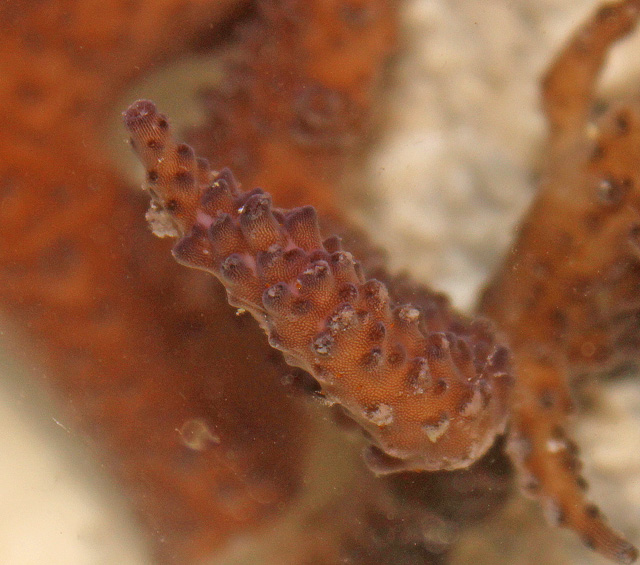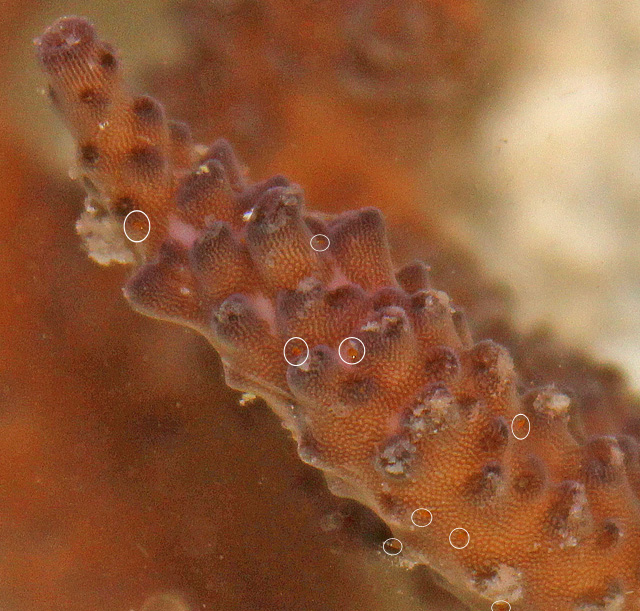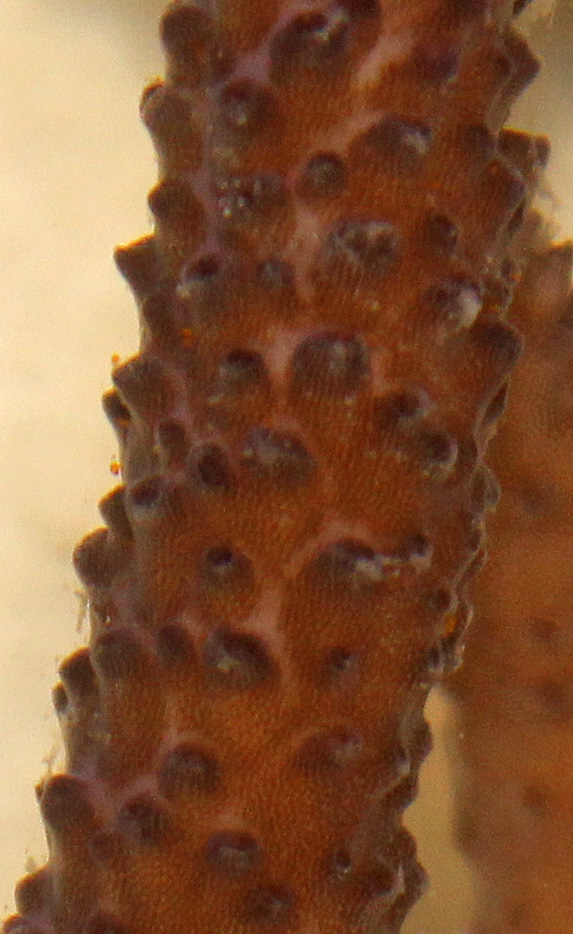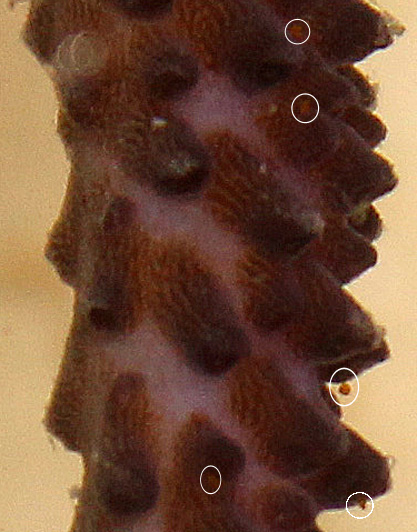Jump to:
Red Acropora Bugs
Tegastes acroporanus

Most saltwater hobbyists will deal with pests</a > at some point. Maybe they traded coral frags with a friend. Maybe they bought wild collected corals and failed to quarantine or treat it. Whatever the reason, some reef aquariums with acropora species of corals may become infested with a pest commonly called red bugs. These red bugs feed on smooth skinned Acropora spp.</a > such as A. granulosa, A. tortuosa, A. caroliniana, and A. echinata. Red bugs do not always kill the coral on which they live. But they can affect growth rate and overall health. It is also considered a bad practice to knowingly trade or sell infested corals to other hobbyists without first explaining the issue. Please scroll down to skip to the treatment.

Red bugs are actually Tegastes acroporanus, a species of copepod (crustacean). They are in the phylum Arthropoda, subphylum Crustacea, class Maxillopda, subclass Copepoda, order Harpacticoida, family Tegastidae, and genus Tegastes. Most copepods are beneficial to your reef system, oftentimes providing an important food source for other invertebrates and fish, like Mandarin dragonets</a >. In contrast, T. acroporanus can be harmful to some of your acros and prevent them from thriving. Tegastes spp. are harpacticoida copepods that look more like amphipods than copepods. Their bodies are laterally compressed, and they have short primary antennae, followed by secondary biramos (branched) antennae. In other copepods, the first antennae are conspicuously long. In their larval form, called a naupilus, they have a mandible that looks like a claw. Tegastes spp. are benthic creatures, meaning they stay to the lowest level of a body of water. Other than a couple of species found near hydrothermal vents, they are found only in shallow waters around the world. These associate with other organisms, such as algae, bryozoans, or corals. You can see other Tegastes spp. under a microscope in pictures found the following scientific article here</a >. T. acroporanus specifically associates with Acropora spp. and are red in color.

The chemical commonly used for treatment is called Interceptor, which is a prescription medication for dogs. It is used to treat for heartworms, hookworms, roundworms, and whipworms. The active ingredient in Interceptor is Milbemycin oxime</a >. It is considered to be a broad spectrum parasitic, as it is effective against not just worms, but also insects, mites, nematodes, and other invertebrates like copepods. Specifically, Milbemycin oxime opens chloride channels in nerve and muscle cells (neurons and myocytes) in many invertebrates. This effectively stops all signal transfers in these cells, killing the invertebrates.
Since Interceptor may also kill invertebrates</a > like shrimp, crabs, and plankton it is best to treat the affected acropora corals outside of your reef tank in a quarantine tank. If this is not possible, prior to treatment, you will want to remove beneficial invertebrates from your system. Of course, your plankton population</a > should rebound with time. Some saltwater hobbyists add fresh macro algae to their sump when the treatments are completed to jump start this process.
Treatment:
The following treatment is recommended after you thoroughly research the use of any chemical treatment in your tank prior to use to understand the benefits and possible drawbacks.
Interceptor tablets used are for large dogs, weighing 51-100 pounds. Boxes of the medication come in packs of 6, each tablet weighing almost 1 gram. You will need to ask your veterinarian for the prescription.
Treating your whole aquarium:
This will take at least 6 hours. It is recommended to use a minimum of 3 treatments, 1 week apart. Use 25mg per 10 gallons of aquarium water. Make sure to account for water displacement from your rocks and substrate. Include the water in your sump and plumbing. Each tablet, when ground, treats 380 gallons. Grind the tablets to a fine power, preferably using a mortar and pestle. When possible, use a scale that measures to 0.001 grams to ensure accuracy. Measure out the powder onto the scale, and be as accurate as possible. Remember, it is just 25mg per 10 gallons of water.
- Turn off your skimmer, ozone generators, UV sterilzers, and any mechanical filtration. Remove any carbon. Your pump stays on, as you still want water to circulate into your sump/refugium to treat any red bugs there. You also want to treat the water inside your calcium reactor and skimmer (while the skimmer is off).
- Remove any invertebrates you want to save, like shrimp and crabs. It is slightly possible they will be infested as well, so red bugs may be reintroduced after the treatment.
- Dissolve the premeasured powder into some aquarium water, stirring frequently. Once it is dissolved, spread the mixture on top of the water.
- Wait 6 hours! You aquarium water should look normal during the whole treatment. If anything looks like it is going wrong during the treatment, immediately do a water change and add activated carbon.
- After the 6 hours is up, do at least a 25% water change and add activated carbon. It should be safe to reintroduce your invertebrates after the water change. The red bugs have died, but you may still see them on your corals. You can blow their little bodies off of your Acropora sp. with a pipette or turkey baster.
- Do another 25% water change 24 hours later and replace the activated carbon.
- Repeat the above process 7 days later, and a last treatment another 7 days after that. The subsequent treatments are to eliminate the copepods that were in their egg and larval (naupilus) stages at the time of the first treatment.
Treatment in a quarantine tank:
If you have obtained a new acro, or would like to treat corals outside of your system to avoid harming your invertebrates, you can adjust this treatment for a quarantine tank.
This will also take at least 6 hours. It is recommended to use a minimum of 3 treatments, 1 week apart. Use 25mg of ground Interceptor per 10 gallons of aquarium water. Some experts online have even adapted this for as little as a gallon and a half of water. Grind the tablets to a fine power, preferably using a mortar and pestle. When possible, use a scale that measures to 0.001 grams to ensure accuracy. Measure out the powder onto the scale, and be as accurate as possible. Remember, it is just 25mg per 10 gallons of water.
- Set up a quarantine tank, complete with heater, lighting, and powerhead for water flow.
- Add the desired amount of water from your existing aquarium.
- Dissolve the premeasured powder into some aquarium water, stirring frequently. Once it is dissolved, spread the mixture on top of the water.
- Add your coral to the quarantine tank.
- Wait 6 hours! You aquarium water should look normal during the whole treatment. If anything looks like it is going wrong during the treatment, immediately remove the coral, empty the quarantine tank, rinse, and refill with aquarium water.
- After the 6 hours is up, blow the dead bug bodies and slime coating from your acro. Remove your coral to a bucket with more of your aquarium water and set aside. Empty and rinse the quarantine tank, and rinse the pump and heater.
- Refill the quarantine tank with water from your aquarium, and replace your coral. To avoid infecting your other corals or main aquarium, you will want to keep your coral quarantined for the duration of the minimum 3 week treatment.
- Repeat the above process 7 days later, and a last treatment another 7 days after that just to be sure your corals are free of red bugs. The subsequent treatments are to eliminate the red bug copepods that were in their egg and larval (naupilus) stages at the time of the first treatment.
- If you still see the tiny red specs in the tank indicating red bugs after the treatment period you should plan to keep the corals in quarantine and retreat every week until the bugs are gone.

References
Arbizu, P. M., Gollner, S., & Ivanenko, V.N. (2008). A new species of deep-sea Tegastidae (Crustacea: Copepoda: Harpacticoida) from 9°50´N on the East Pacific Rise, with remarks on its ecology. </em >Zootaxa, 1866: 323-326. Retrieved on January 1st, 2012 from http://www.mapress.com/zootaxa/2008/f/zt01866p336.pdf</a >
Milbemycin oxime. (2012). Wikipedia. Retrieved on January 6th, 2012, from http://en.wikipedia.org/wiki/Milbemycin_oxime</a >
